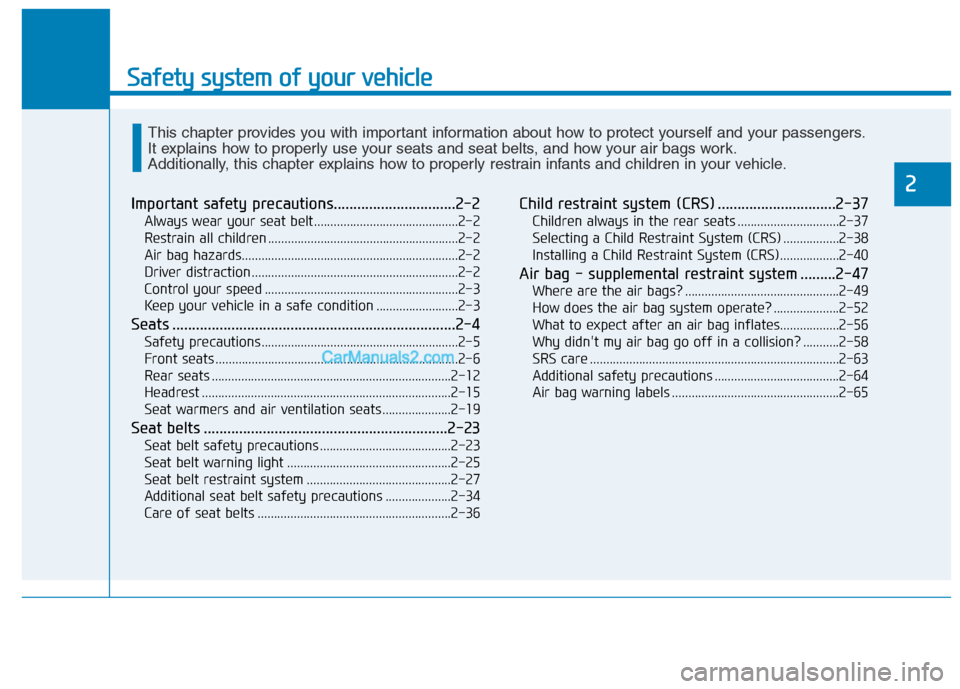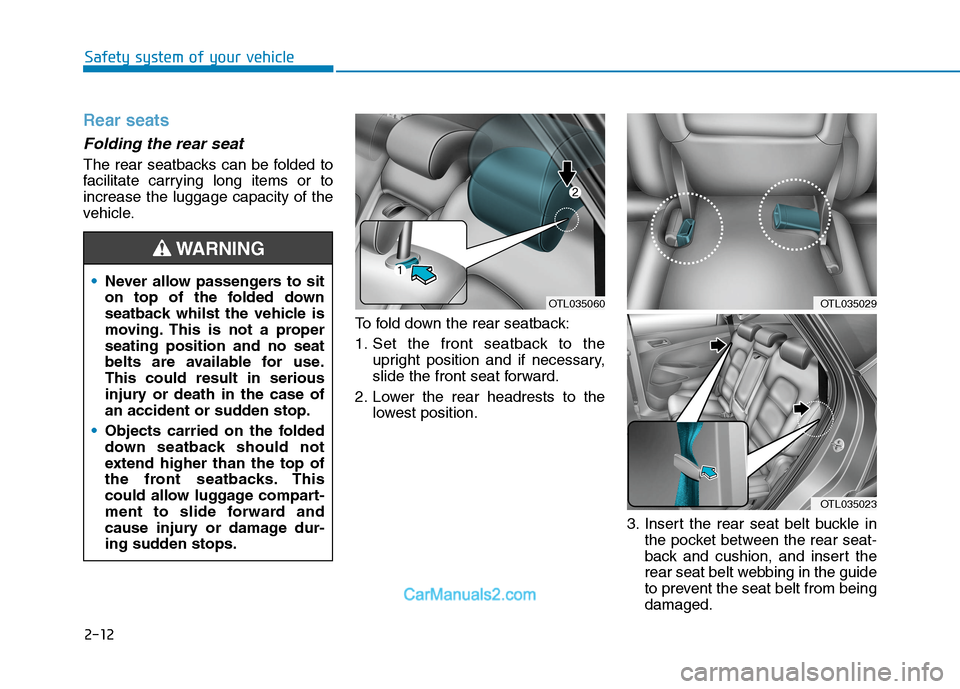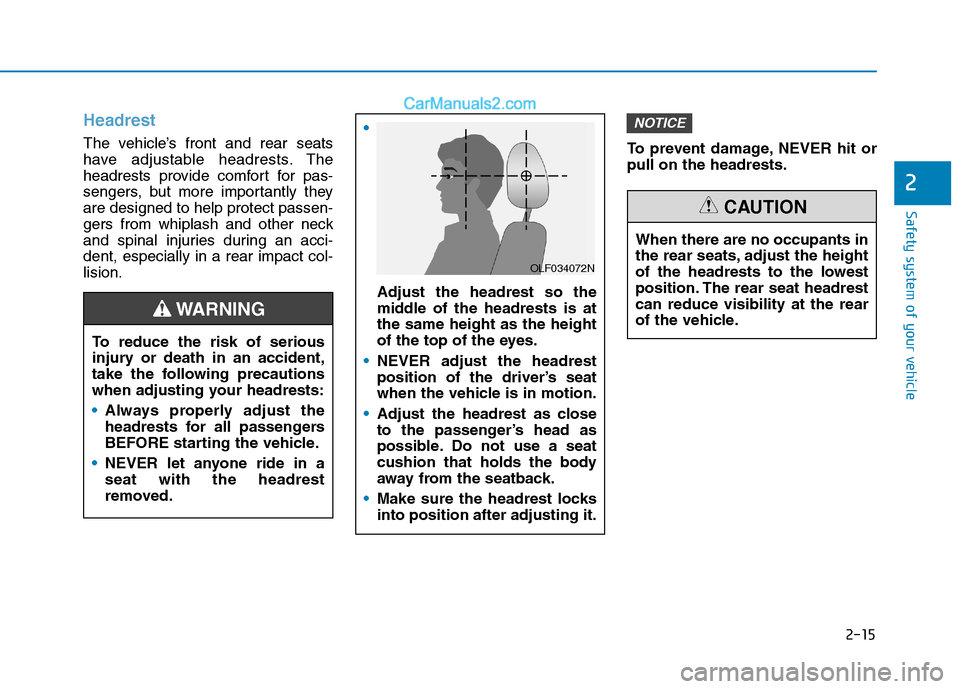Page 22 of 637

Safety system of your vehicle
2
Important safety precautions...............................2-2
Always wear your seat belt............................................2-2
Restrain all children ..........................................................2-2
Air bag hazards..................................................................2-2
Driver distraction ...............................................................2-2
Control your speed ...........................................................2-3
Keep your vehicle in a safe condition .........................2-3
Seats ........................................................................2-4
Safety precautions............................................................2-5
Front seats ..........................................................................2-6
Rear seats .........................................................................2-12
Headrest ............................................................................2-15
Seat warmers and air ventilation seats.....................2-19
Seat belts ..............................................................2-23
Seat belt safety precautions ........................................2-23
Seat belt warning light ..................................................2-25
Seat belt restraint system ............................................2-27
Additional seat belt safety precautions ....................2-34
Care of seat belts ...........................................................2-36
Child restraint system (CRS) ..............................2-37
Children always in the rear seats ...............................2-37
Selecting a Child Restraint System (CRS) .................2-38
Installing a Child Restraint System (CRS)..................2-40
Air bag - supplemental restraint system .........2-47
Where are the air bags? ...............................................2-49
How does the air bag system operate? ....................2-52
What to expect after an air bag inflates..................2-56
Why didn't my air bag go off in a collision? ...........2-58
SRS care ............................................................................2-63
Additional safety precautions ......................................2-64
Air bag warning labels ...................................................2-65
This chapter provides you with important information about how to protect yourself and your passengers.
It explains how to properly use your seats and seat belts, and how your air bags work.
Additionally, this chapter explains how to properly restrain infants and children in your vehicle.
Page 25 of 637
2-4
Safety system of your vehicle
S SE
EA
AT
TS
S
OTL035001R
Front seats
(1) Forward and rearward
(2) Seatback angle
(3) Seat cushion height (Driver’s seat)
(4) Lumbar support (Driver’s seat)*
(5) Seat warmer*
(6) Air ventilation seat*
(7) Headrest
Rear seats
(8) Seatback angle and folding
(9) Headrest
(10) Armrest
(11) Seat warmer*
* : if equipped
Power seat
Manual seat
Page 33 of 637

2-12
Safety system of your vehicle
Rear seats
Folding the rear seat
The rear seatbacks can be folded to
facilitate carrying long items or to
increase the luggage capacity of the
vehicle.
To fold down the rear seatback:
1. Set the front seatback to the
upright position and if necessary,
slide the front seat forward.
2. Lower the rear headrests to the
lowest position.
3. Insert the rear seat belt buckle in
the pocket between the rear seat-
back and cushion, and insert the
rear seat belt webbing in the guide
to prevent the seat belt from being
damaged. Never allow passengers to sit
on top of the folded down
seatback whilst the vehicle is
moving. This is not a proper
seating position and no seat
belts are available for use.
This could result in serious
injury or death in the case of
an accident or sudden stop.
Objects carried on the folded
down seatback should not
extend higher than the top of
the front seatbacks. This
could allow luggage compart-
ment to slide forward and
cause injury or damage dur-
ing sudden stops.
WARNING
OTL035060OTL035029
OTL035023
Page 36 of 637

2-15
Safety system of your vehicle
2
Headrest
The vehicle’s front and rear seats
have adjustable headrests. The
headrests provide comfort for pas-
sengers, but more importantly they
are designed to help protect passen-
gers from whiplash and other neck
and spinal injuries during an acci-
dent, especially in a rear impact col-
lision.To prevent damage, NEVER hit or
pull on the headrests.
NOTICE
When there are no occupants in
the rear seats, adjust the height
of the headrests to the lowest
position. The rear seat headrest
can reduce visibility at the rear
of the vehicle.
CAUTION
To reduce the risk of serious
injury or death in an accident,
take the following precautions
when adjusting your headrests:
Always properly adjust the
headrests for all passengers
BEFORE starting the vehicle.
NEVER let anyone ride in a
seat with the headrest
removed.
Adjust the headrest so the
middle of the headrests is at
the same height as the height
of the top of the eyes.
NEVER adjust the headrest
position of the driver’s seat
when the vehicle is in motion.
Adjust the headrest as close
to the passenger’s head as
possible. Do not use a seat
cushion that holds the body
away from the seatback.
Make sure the headrest locks
into position after adjusting it.
WARNING
OLF034072N
Page 37 of 637
2-16
Safety system of your vehicle
Front seat headrests
The driver’s and front passenger’s
seats are equipped with adjustable
headrests for the passengers safety
and comfort.
Forward and rearward adjustment
The headrest may be adjusted for-
ward to 3 different positions by
pulling the headrest forward to the
desired detent. To adjust the head-
rest to it’s furthest rearwards posi-
tion, pull it fully forward to the farthest
position and release it.
Adjusting the height up and down
To raise the headrest:
1. Pull it up to the desired position
(1).
To lower the headrest:
1. Push and hold the release button
(2) on the headrest support.
2. Lower the headrest to the desired
position (3).
OLMB033009
OTL035014OTL035009
Page 38 of 637
2-17
Safety system of your vehicle
2
If you recline the seatback
towards the front with the head-
rest and seat cushion raised, the
headrest may come in contact
with the sunvisor or other parts of
the vehicle.
Removal/Reinstall
To remove the headrest:
1. Recline the seatback (2) with
using the seatback angle lever or
switch (1).2. Raise the headrest as far as it can
go.
3. Press the headrest release button
(3) whilst pulling the headrest up
(4).
NOTICE
NEVER allow anyone to travel in
a seat with the headrest
removed.
WARNING
OLF034015
OTL035010R
■Type A
OTLE035011R
■Type B
Page 39 of 637
2-18
Safety system of your vehicle
To reinstall the headrest :
1. Recline the seatback.
2. Put the headrest poles (2) into the
holes whilst pressing the release
button (1).3. Adjust the headrest to the appro-
priate height.
4. Recline the seatback (4) with the
seatback angle lever or switch (3).
Rear seat headrests
The rear seats are equipped with
headrests in all the seating positions
for the passenger’s safety and com-
for t.
OLMB033016
Always make sure the headrest
locks into position after rein-
stalling and adjusting it proper-
ly.
WARNING
OTL035012R
■Type A
OTLE035013R
■Type B
Page 40 of 637

2-19
Safety system of your vehicle
2
Adjusting the height up and down
To raise the headrest:
1. Pull it up to the desired position
(1).
To lower the headrest:
1. Push and hold the release button
(2) on the headrest support.
2. Lower the headrest to the desired
position (3).
Seat warmers and air ventila-
tion seats
Front seat warmers
(if equipped)
Seat warmers are provided to warm
the seats during cold weather.
To prevent damage to the seat
warmers and seats:
Never use a solvent such as
paint thinner, benzene, alcohol
or petrol to clean the seats.
Do not place heavy or sharp
objects on seats equipped with
seat warmers.
Do not change the seat cover. It
may damage the seat warmer.
NOTICE
The seat warmers can cause a
SERIOUS BURN, even at low
temperatures and especially if
used for long periods of time.
Passengers must be able to feel
if the seat is becoming too
warm so they can turn it off, if
needed.
People who cannot detect tem-
perature change or pain to the
skin should use extreme cau-
tion, especially the following
passengers:
Infants, children, elderly or
disabled persons, or hospital
outpatients.
People with sensitive skin or
who burn easily.
Fatigued individuals.
Intoxicated individuals.
People taking medication that
can cause drowsiness or
sleepiness.
WARNING
NEVER place anything on the
seat that insulates against heat
when the seat warmer is in oper-
ation, such as a blanket or seat
cushion. This may cause the
seat warmer to overheat, caus-
ing a burn or damage to the seat.
WARNING
OTL035018